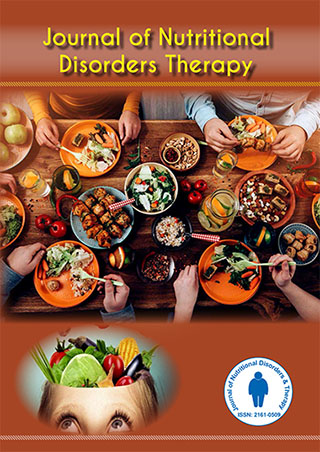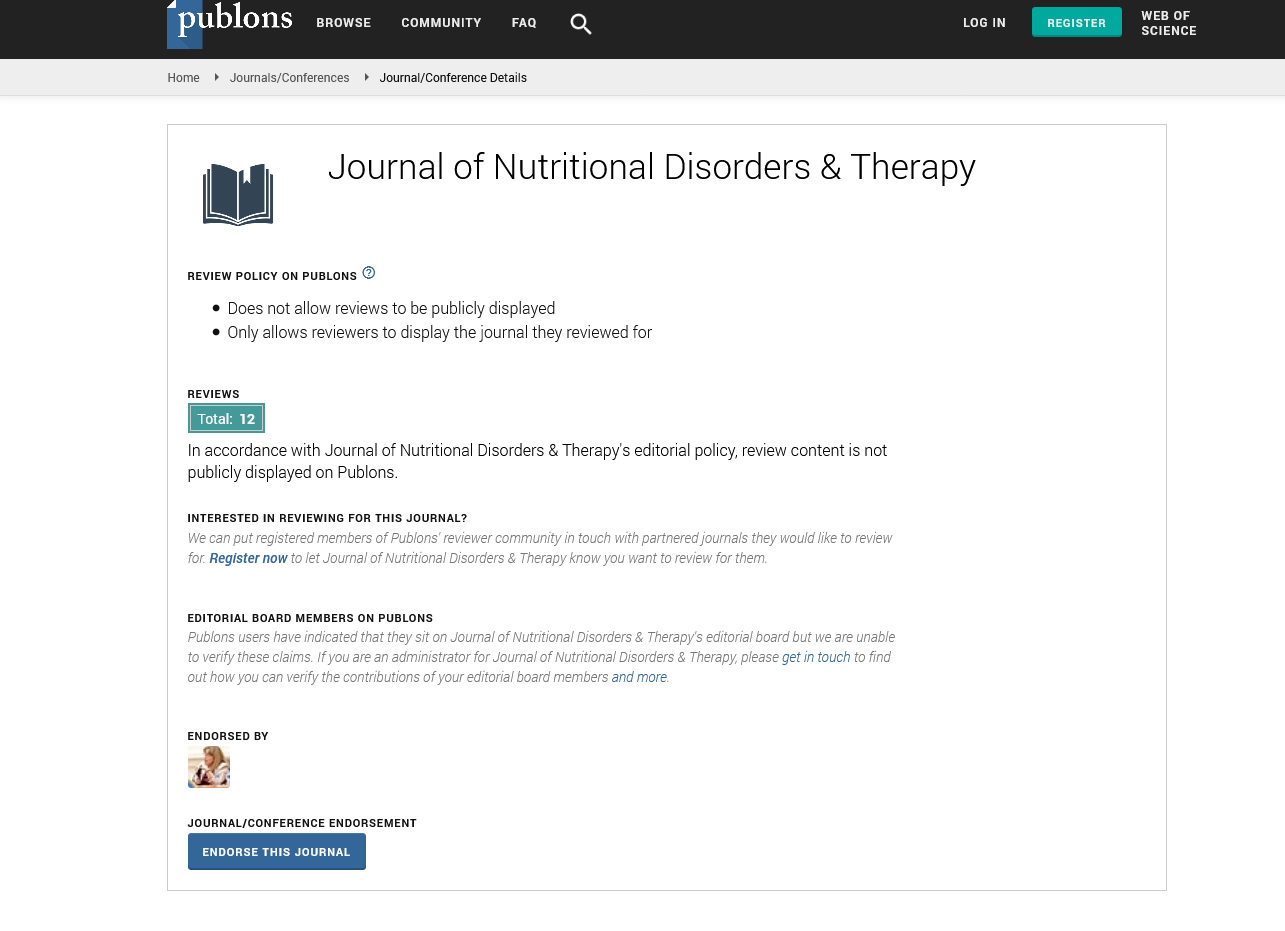Indexed In
- Open J Gate
- Genamics JournalSeek
- Academic Keys
- JournalTOCs
- Ulrich's Periodicals Directory
- RefSeek
- Hamdard University
- EBSCO A-Z
- OCLC- WorldCat
- Publons
- Geneva Foundation for Medical Education and Research
- Euro Pub
Useful Links
Share This Page
Journal Flyer

Open Access Journals
- Agri and Aquaculture
- Biochemistry
- Bioinformatics & Systems Biology
- Business & Management
- Chemistry
- Clinical Sciences
- Engineering
- Food & Nutrition
- General Science
- Genetics & Molecular Biology
- Immunology & Microbiology
- Medical Sciences
- Neuroscience & Psychology
- Nursing & Health Care
- Pharmaceutical Sciences
Perspective - (2025) Volume 15, Issue 1
Nutrition Challenges across the Spectrum of Deficiency and Excess
Sergio Bine*Received: 25-Feb-2025, Manuscript No. JNDT-25-29112; Editor assigned: 27-Feb-2025, Pre QC No. JNDT-25-29112 (PQ); Reviewed: 13-Mar-2025, QC No. JNDT-25-29112; Revised: 20-Mar-2025, Manuscript No. JNDT-25-29112 (R); Published: 27-Mar-2025, DOI: 10.35248/2161-0509.25.15.316
Description
Malnutrition encompasses a spectrum of nutrition-related health conditions. Traditionally associated with poverty and food scarcity, malnutrition was largely framed around undernutrition, including stunting, wasting, underweight and deficiencies in essential vitamins and minerals. However, over the past few decades, changes in food availability, dietary patterns and sedentary lifestyles have contributed to a global increase in overweight and obesity. These opposing conditions can coexist within the same country, community, household, or even individual — a situation known as the "double burden of malnutrition."
The Global Burden of Disease (GBD) framework provides robust tools for tracking changes in health outcomes associated with these conditions across time and geography. The aim of this article is to analyze the GBD data in the context of both undernutrition and overweight/obesity, drawing attention to the evolving challenges that health systems must navigate.
Defining the dual nature of malnutrition
Undernutrition: Stunting (low height for age), wasting (low weight for height), underweight (low weight for age) and micronutrient deficiencies.
Overnutrition: Overweight and obesity, characterized by excess body fat accumulation that increases the risk of Non-Communicable Diseases (NCDs).
This dual nature reflects both insufficient and excessive intake of nutrients, often influenced by socioeconomic, environmental and behavioral factors.
Global trends based on GBD data
According to recent GBD estimates, undernutrition remains a leading contributor to child mortality and impaired development in low-income countries. Key statistics includes in 2021, stunting affected approximately 22% of children under five globally. Wasting was responsible for about 45 million cases, with the highest prevalence in South Asia and sub-Saharan Africa. Micronutrient deficiencies, particularly iron, vitamin A, and zinc, continue to affect millions and contribute to impaired immunity, cognitive deficits and maternal complications.
Childhood undernutrition has far-reaching consequences beyond mortality, including reduced educational attainment, lower productivity and increased susceptibility to disease throughout life.
Overweight and obesity
In contrast, overweight and obesity have risen sharply across all regions — as of the latest GBD data, over 2 billion adults are overweight and more than 650 million are obese. Childhood obesity is rising rapidly, especially in urban areas of middle-income countries. Obesity-related NCDs such as cardiovascular disease, diabetes, osteoarthritis and certain cancers have increased significantly.
Countries in transition often experience the paradox of persistent undernutrition alongside rising overweight rates, challenging the traditional understanding of food insecurity.
Undernutrition as a risk factor
In children under five, undernutrition including stunting, wasting and suboptimal breastfeeding accounts for millions annually. Protein-energy malnutrition is strongly associated with increased susceptibility to infections such as pneumonia, diarrhea and malaria. Maternal undernutrition affects birth outcomes, increasing neonatal mortality and long-term developmental delays.
Socioeconomic and behavioral determinants
A key finding from GBD and associated nutrition studies is that malnutrition is not only a matter of food quantity but also of food quality. Several contributing factors are shared across both extremes:
- Poverty: Affects access to diverse diets, clean water, healthcare and education.
- Education: Maternal education strongly predicts child nutrition outcomes.
- Urbanization: Associated with sedentary lifestyles and increased consumption of processed foods.
- Food environments: Availability and marketing of unhealthy foods contribute to poor dietary choices.
Behavioral factors, including feeding practices, meal frequency and dietary diversity, are shaped by culture, income and access.
Addressing malnutrition thus requires interventions beyond food distribution, including education and policy changes.
Monitoring and evaluation
Accurate and timely data are essential for measuring progress. GBD and similar global surveillance efforts enable comparison over time and across populations. However, countries should also strengthen national health information systems to:
- Track malnutrition trends more locally,
- Identify high-risk groups,
- Evaluate intervention effectiveness,
- Guide resource allocation
Undernutrition and overweight/obesity represent two interconnected challenges under the umbrella of malnutrition. Both are influenced by social, economic and environmental factors and both contribute significantly to the global burden of disease. The GBD study highlights the shifting patterns of malnutrition and its expanding impact across all age groups and regions. Addressing this dual burden requires coordinated efforts that prioritize equity, prevention and sustainable food systems. Health systems must adapt to recognize and respond to the full spectrum of nutritional challenges affecting populations today.
Citation: Bine S (2025). Nutrition Challenges across the Spectrum of Deficiency and Excess. J Nutr Disord Ther. 15:316.
Copyright: © 2025 Bine S. This is an open-access article distributed under the terms of the Creative Commons Attribution License, which permits unrestricted use, distribution, and reproduction in any medium, provided the original author and source are credited.

